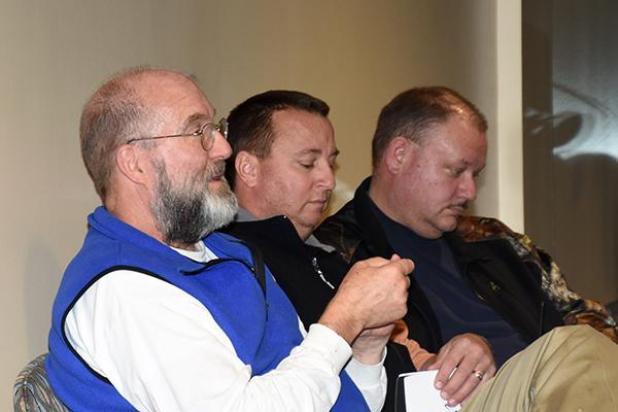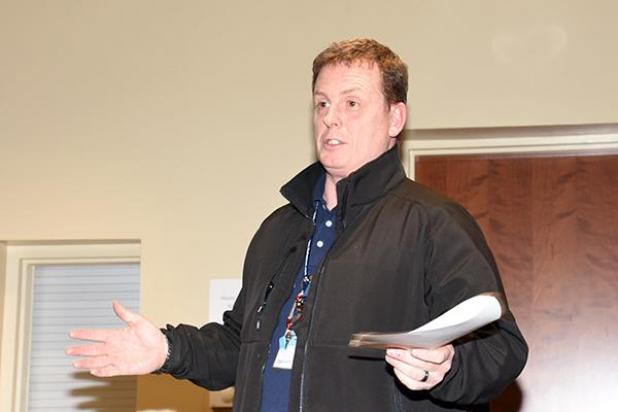
Pictured from left, Dr. Dennis Jelden, Emergency Management Director Bob Heldenbrand and Police Chief Doug Bergstrom all have experience being on call as well as a vested interest in the future of East Phillips County EMS. —Johnson Publications photo

EMS director Brady Ring addresses the need to reinvigorate EMT volunteers at Wednesday’s community EMS meeting. —Johnson Publications photo
Community calls for more EMTs
A call for more EMTs and some restructuring within emergency medical services was the main takeaway from the Wednesday, Feb. 8, community EMS meeting at Melissa Memorial Hospital.
Around 20 community members gathered in the clinic waiting room at MMH to air grievances and discuss the future of East Phillips County EMS with the new full-time EMS director Brady Ring, MMH CEO Trampas Hutches and operations director Heather Cloward.
“We need to get behind ourselves,” said Naomi Newman, a former EMT and registered nurse who was present at the meeting. “We’ve got to have an obligation. We’re good people, we’re a good community and a good county.”
With ambulances owned by Phillips County, community volunteers, a full-time EMS director at MMH and a desire for more full-time EMS employees, a great deal of collaboration and support is needed from all sides — hospital, county and community — to ensure a successful service.
In opening remarks, Hutches briefly alluded to “the whole county’s EMS services.” While the potential for a consolidated EMS service is still just an idea and a long way from reality, it still piqued attention in the room.
Dennis Jelden, a former doctor who has worked at both MMH and Haxtun Hospital District, noted the potential politics between the rival towns of Haxtun and Holyoke that could result from trying to consolidate services — touchy subjects like funding or who has the paramedics versus basic level EMTs.
In the end, however, he agreed, “Ultimately, the solution may need to be a countywide solution.” Jelden said Haxtun’s EMS faces many of the same problems as Holyoke’s.
Perhaps the biggest item of concern was the need for not just more volunteers, but more with the proper levels of training, enabling more transfers from local EMS services.
There are various levels of life support care that require different credentials. Some EMTs are only credentialed in basic life support while others are trained in advanced life support, enabling them to administer more medications and perform more procedures. Paramedics are the most advanced level of EMT.
Holyoke’s EMS currently has three paramedics within its 15 volunteers, including one new addition, one who is recently back from leave and Ring, who just began at MMH in late December. In 2016, the department missed 97 ground transfers to higher care facilities, often calling on available EMTs from Wray or Yuma who had advanced enough training to support the patients while transporting them.
“The first five to 10 minutes of care are pretty much the same,” said Ring, “but the longer you’re with a patient, the more intensive the care becomes and the more you need a paramedic.”
“Our EMTs can come quickly and do everything they can, but if no one can go, then no one can go,” said Newman, adding how frustrating it is for a patient to make it to MMH’s emergency room and be stabilized, only to be stuck waiting for another ambulance.
Currently, much of Ring’s time is dedicated to monitoring the schedule, keeping the 120 shifts per month covered by 15 volunteers. “That’s asking a lot,” he said.
Discussing the need for more volunteers and support for EMTs, Jelden said he wasn’t sure that most people appreciate what it means to be on call.
“You don’t always have to do anything, but you also can’t do anything,” he said, explaining the often unrecognized commitment put forth by EMT volunteers. They commit to missing personal and public events “just in case.”
Jelden went on to point out what it’s like when a person does get that call — for example, being called at midnight for a transfer to Loveland when the volunteer also needs to be at their full-time job at 7 a.m.
In terms of recruiting and retaining EMTs, Ring looks forward to reinvigorating volunteers and sharing the excitement of the program.
“At least a couple times every day I get that adrenaline rush,” said Ring. “To get that training and get out and use it is exciting. I want to get that message out.”
Ring plans to reach out to individuals starting at the high school level to get them interested in the emergency medical profession through CPR and first-aid classes.
Education for EMTs will also be a major focus. “The more you’re trained, the more you’re into it,” he said. Training is also imperative for the sake of getting up to date on advancements in protocol.
The addition of full-time paramedics and basic EMTs could also be in the future, but there were a lot of questions about how to fund such a venture — and who should be responsible for funding it.
Suggestions by the group present ranged from mill levy funds to reimbursements from the transfers conducted. Last year’s 97 transfers equated to about $167,000 in lost revenue, although that rate could change in the future and does not account for contractual adjustments depending on insurance.
Hutches is particularly interested in following the model of Hugo’s hospital, employing paramedics in the emergency department when they are not on call or transferring patients. MMH is applying for a $500,000 grant for an emergency department paramedic program.
Another major focus for the EMS department’s future is standardizing its two ambulances to be exactly alike. Currently, one is set up for emergency response, while the other is set up for transfers.
“Both need to be set up the same,” said Ring. “You can’t have staff in an ambulance they’re not familiar with.”
Likewise, each ambulance needs to have exactly the same equipment. The new pediatric packs the department is working to acquire is one step in that direction.
Ring said the department built its own bags of pediatric equipment before, but each is different. “Different” isn’t a desired trait in a high-stress situation with a child’s life in danger.
Still, the need for more EMTs and support for them reined in overall discussion. There are EMTs in other areas of the community such as the police department who could potentially help in an emergency, but that alone doesn’t solve the problem.
“They’ve already got many hats and a full-time job,” said Bob Heldenbrand, Emergency Management director. “We need more people and apparently need to adjust our programs.”
